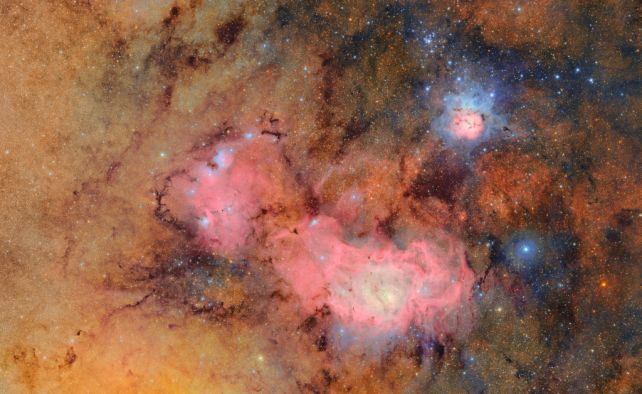The Vera C. Rubin Observatory has simply dropped its very first pictures. Anticipated to revolutionize our understanding of the Universe, the brand new eye on the sky hasn’t upset.
For 10 hours, the US Nationwide Science Basis and Division of Power facility stared deep into the cosmos, utilizing its highly effective digicam to report in near-ultraviolet, optical, and near-infrared wavelengths. The result’s a tantalizing and thrilling set of observations that bode nicely for the years to come back.
“NSF-DOE Rubin Observatory will seize extra details about our Universe than all optical telescopes all through historical past mixed,” says Brian Stone, performing director of the NSF. “By this outstanding scientific facility, we’ll discover many cosmic mysteries, together with the darkish matter and darkish vitality that permeate the Universe.”
Rubin’s first mission is a 10-year survey of the southern sky referred to as the Legacy Survey of Area and Time (LSST). Each few days, it is going to observe your entire sky, recording every part round 800 occasions utilizing the telescope’s 3,200-megapixel digicam (the biggest on this planet) to successfully compile an unprecedented 10-year timelapse of the Universe.
Associated: The Universe’s Largest Map Has Arrived, And You Can Stargaze Like By no means Earlier than
The mission is designed to seize something that strikes, flashes, or pulses – a remit that features asteroids, comets, supernovae, and pulsars; from taking an asteroid stock of the Photo voltaic System to cataloguing exploding stars billions of light-years away.

In its first pictures, Rubin demonstrates a few of that vary, recording an especially detailed, huge picture of the Milky Manner Trifid and Lagoon nebulae, two dense molecular clouds effervescent with hidden star formation. In 7.2 hours, the telescope took 678 particular person pictures for a closing mosaic coming in at slightly below 5 gigapixels.
It’s best to go have a play with the interactive zoomable picture – it is a delight.
In one other picture, the observatory showcases its means to zoom in on a patch of sky, revealing round 10 million galaxies in a tightly targeted subject of view across the Virgo cluster. There is a zoomable model right here.

frameborder=”0″ permit=”accelerometer; autoplay; clipboard-write; encrypted-media; gyroscope; picture-in-picture; web-share” referrerpolicy=”strict-origin-when-cross-origin” allowfullscreen>
Lastly, the Rubin workforce revealed the Photo voltaic System asteroids the telescope was in a position to observe – together with a whopping 2,104 orbiting bits of rock we have by no means seen earlier than, in simply over 10 hours of observations.
Yearly, about 20,000 new asteroids are found by all different ground-based telescopes mixed – Rubin seems to blow them out of the water.
Not one of the asteroids found by Rubin pose a hazard to Earth, however the discoveries present what a robust device the observatory can be in Earth protection in opposition to hazardous house rocks.

frameborder=”0″ permit=”accelerometer; autoplay; clipboard-write; encrypted-media; gyroscope; picture-in-picture; web-share” referrerpolicy=”strict-origin-when-cross-origin” allowfullscreen>
“Rubin Observatory is the primary of its variety: its mirror design, digicam dimension and sensitivity, telescope pace, and computing infrastructure are every in a wholly new class,” the NSF and DOE say.
“With Rubin information we’ll all perceive our Universe higher, chronicle its evolution, delve into the mysteries of darkish vitality and darkish matter, and reveal solutions to questions now we have but to think about.”
Excelsior.


